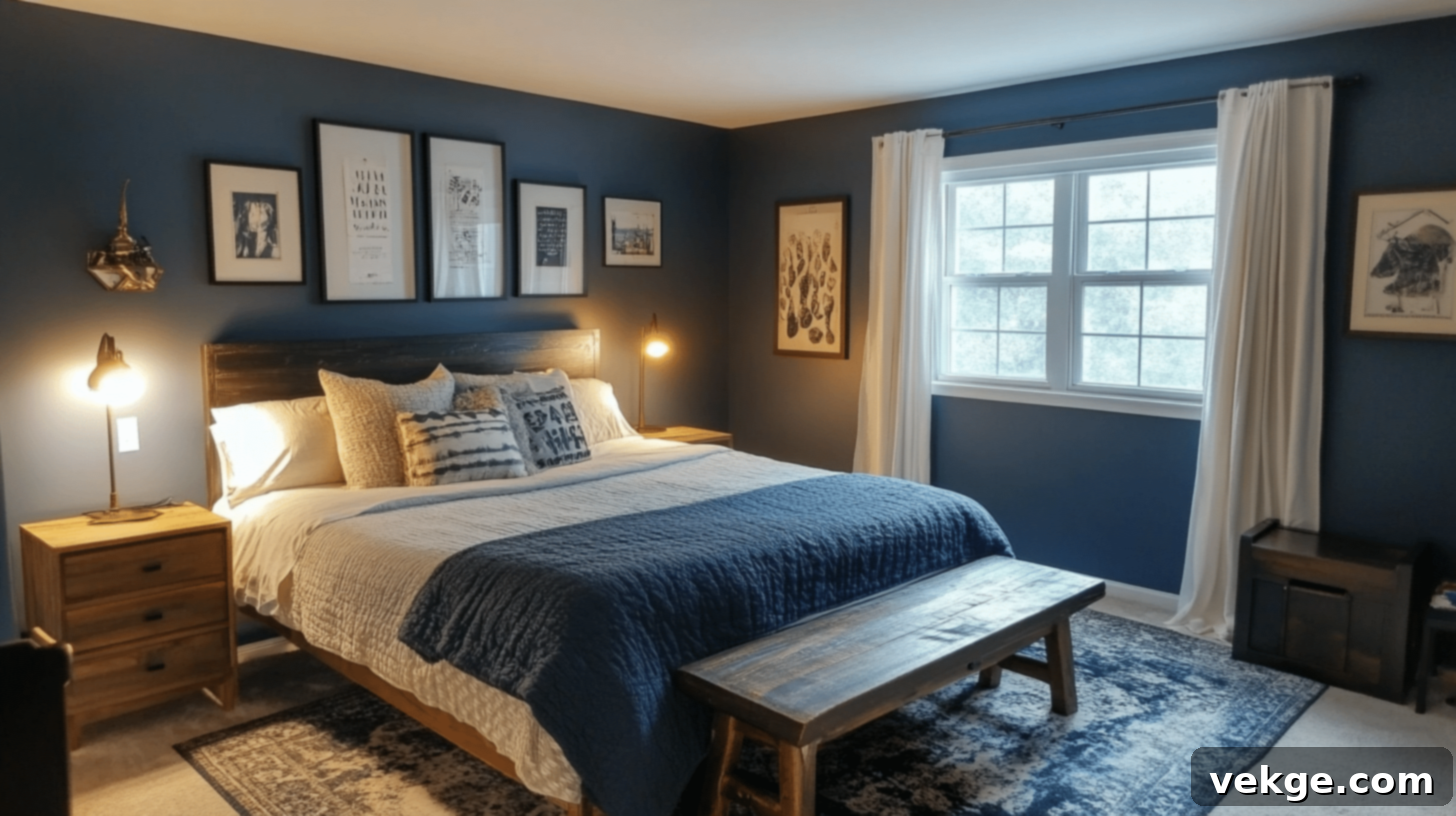Budget-Friendly Room Remodeling Ideas: Transform Your Home on Any Budget
Room remodeling can dramatically change how your home looks, feels, and functions. It’s an opportunity to infuse new life into tired spaces, optimize layouts for better flow, and create environments that truly reflect your style and meet your needs. Contrary to popular belief, a significant home transformation doesn’t always require a hefty budget or a lengthy, disruptive renovation process. With smart planning, creative solutions, and a strategic approach, you can achieve remarkable results.
This comprehensive guide will show you simple yet impactful ways to update your space without breaking the bank or dedicating endless hours. We’ll explore essential steps, from defining your vision and setting a realistic budget to choosing complementary colors, finding versatile furniture for small spaces, and making intelligent choices about lighting and decor. Whether you’re looking to refresh your kitchen, revitalize your bedroom, or enhance your living room, these actionable tips will empower you to create a personalized sanctuary you’ll love spending time in every single day.
Let’s dive into how thoughtful room remodeling can turn an old, uninspiring space into something fresh, functional, and beautifully new.
Define Your Goals and Budget for a Successful Room Remodel
Before you even pick up a paint brush or browse for new furniture, the foundation of any successful room remodeling project lies in clearly defining your goals and establishing a realistic budget. This initial planning phase is crucial for guiding your decisions, preventing costly mistakes, and ensuring the final outcome aligns with your vision.
Understand Why You Are Remodeling
Take a moment to deeply reflect on your primary motivations for renovating. Are you seeking to improve functionality, enhance aesthetics, increase comfort, or boost your home’s resale value? For instance, if you’re tackling a bathroom, do you desperately need more storage space to keep clutter at bay? Is the current shower too cramped, making your daily routine less enjoyable? Are you simply tired of outdated fixtures and finishes that no longer align with your style? Write down every pain point and every aspiration you have for the space. This detailed list will help you focus on the most impactful changes and avoid spending precious resources on elements you don’t truly need or desire.
Set a Realistic Budget
Understanding the financial scope of your project is paramount. The cost of a room remodel can vary widely based on the extent of the changes. Small, cosmetic updates, such as a fresh coat of paint, new light fixtures, or updated hardware, are typically the most budget-friendly. Medium-range changes might include replacing key items like a sink, toilet, or a new piece of furniture. A complete makeover, involving significant layout changes, new flooring, custom cabinetry, or extensive plumbing and electrical work, will naturally be the most expensive. It’s always wise to allocate an additional 10-20% of your total budget for unexpected issues that frequently arise during renovation work, such as discovering old wiring or water damage once walls are opened up.
Tips for Staying Within Your Remodeling Budget
Sticking to your budget requires discipline and smart decision-making. Here are some effective strategies:
- Maintain the Existing Layout: Major plumbing or electrical alterations are costly. Keeping the current layout of sinks, toilets, and major appliances can significantly reduce expenses.
- Shop Smart for Fixtures: Look for floor model discounts at home improvement stores or explore online retailers and salvage yards for unique, affordable finds.
- Choose Standard Sizes: Custom-sized items, whether it’s cabinetry or windows, come with a premium price tag. Opt for standard dimensions whenever possible.
- Update Hardware: Instead of replacing entire cabinets, simply changing drawer pulls, knobs, and hinges can give your kitchen or bathroom a fresh, modern look at a fraction of the cost.
- Strategic Tiling: To save on extensive tiling, use high-end or decorative tiles as accents (e.g., a backsplash, a shower niche) and pair them with more basic, affordable tiles for larger areas.
- Gather Multiple Quotes: Always get at least three detailed quotes from different contractors to ensure competitive pricing and a clear understanding of the scope of work.
- Purchase Materials Yourself: When feasible, buying materials directly can help you avoid contractor markups. Just be sure to coordinate delivery and storage.
Choose Your Room’s Style
Your chosen style will dictate many of your design decisions, from color palettes to furniture shapes. Popular interior design styles like modern, farmhouse, bohemian, and minimalist offer distinct aesthetics that can profoundly impact the mood of your room. When selecting a style, consider what truly makes you feel calm, happy, and productive. Your room, particularly a bedroom, should serve as a sanctuary that aligns with your daily habits and expresses your unique personality. Explore design magazines, Pinterest, and Instagram to gather inspiration and identify the looks you are most drawn to.
Creating a mood board is an invaluable tool in this process. It helps visualize how different elements come together and ensures a cohesive look:
- Collect Visuals: Start by collecting pictures from magazines, printouts from online sources, or digital pins on Pinterest that showcase colors, textures, and specific items you admire.
- Gather Samples: Include physical samples like fabric swatches, paint chips, wallpaper snippets, and flooring options you’re considering.
- Add Furniture Ideas: Incorporate photos of furniture pieces that could work in your space, noting their style and scale.
- Arrange and Evaluate: Arrange all these elements together on a physical board or in a digital collage. Step back and assess whether your choices create a harmonious look and feel that you love. This process helps solidify your vision and keeps you on track throughout the remodeling journey.
Organizing and Planning the Room for Optimal Design
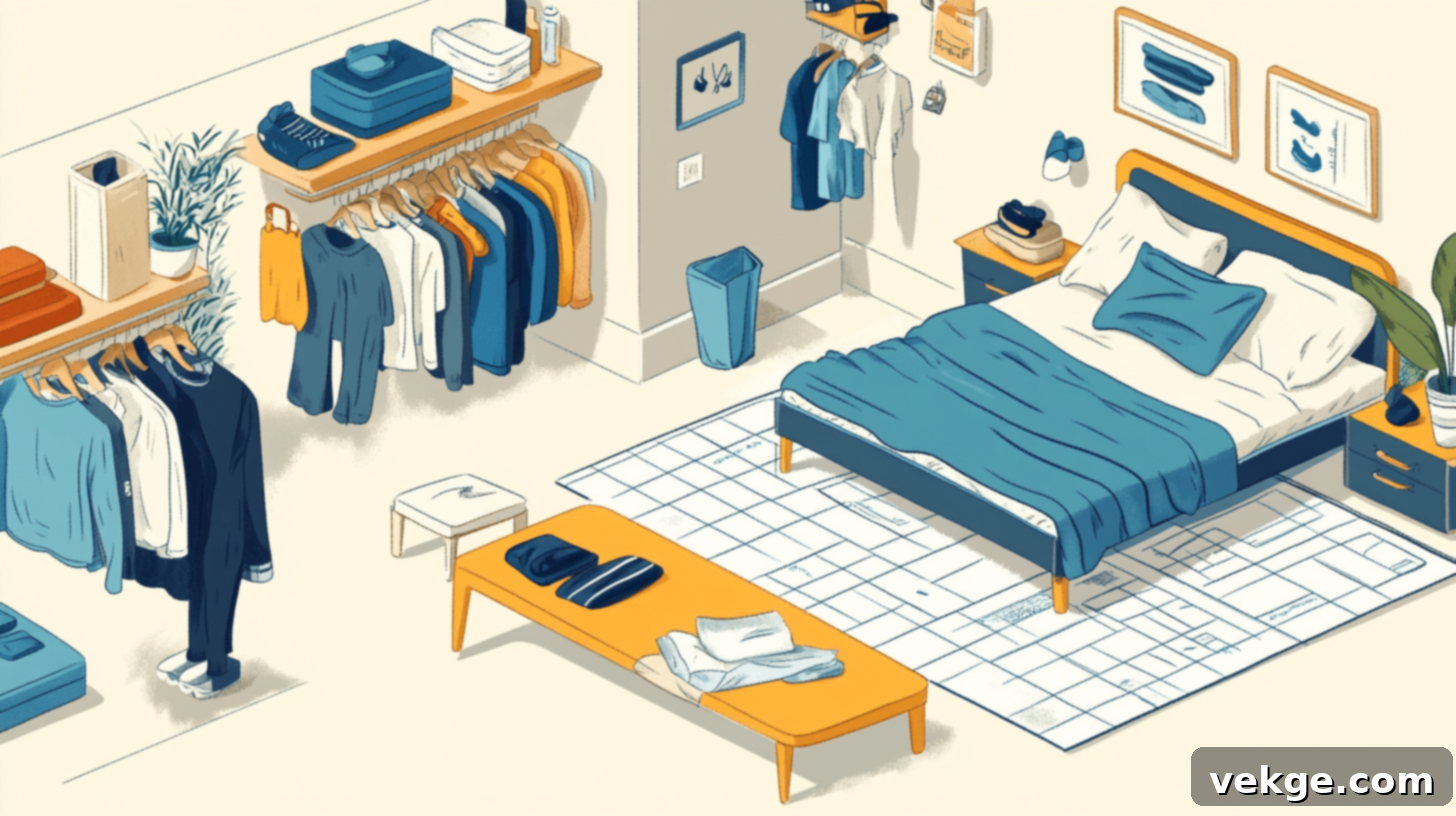
With your goals and style defined, the next crucial step is to prepare your space through thorough organization and meticulous planning. This stage sets the foundation for a functional and aesthetically pleasing remodel.
Decluttering: The First Essential Step
Before any new design element can be introduced, you must first clear out the old. Begin by completely emptying the room you intend to remodel. As you remove items, sort them into three distinct piles: “keep,” “donate/sell,” and “throw away.” Be ruthlessly honest with yourself during this process. A good rule of thumb: if you haven’t used or worn something in a year (or even six months for clothing), you likely don’t need it. For clothes, a clever trick is to turn all your hangers backward. Once you wear an item, flip the hanger forward. After six months or a year, any hangers still facing backward hold items you rarely use, making them prime candidates for donation. Consider storing seasonal items like heavy winter coats or holiday decorations elsewhere to free up valuable space in your newly organized room.
Detailed Planning and Floor Plans
Accurate measurements are the backbone of any good design. Measure your room’s precise dimensions, including the height, width, and depth of walls, as well as the placement and size of windows, doors, and any built-in features like radiators or closets. Transfer these measurements onto graph paper, or utilize one of the many free online room planning apps available. These tools allow you to experiment with different furniture layouts digitally, saving you the physical effort of moving heavy items repeatedly.
When planning your layout, always prioritize functionality and flow. Ensure that walking paths remain clear—ideally at least 30-36 inches wide—to allow for comfortable movement. Also, account for enough space to fully open drawers, closet doors, and entrance doors without obstruction. When positioning your bed, consider factors like morning sunlight, proximity to electrical outlets, and how it impacts the overall balance of the room.
Choosing Furnishings Wisely
The furniture you select plays a pivotal role in both the aesthetics and functionality of your room. For a bedroom, your bed is undoubtedly the centerpiece. Choose a comfortable bed that fits your room’s scale; ideally, it shouldn’t occupy more than half of the total floor space. Always test mattresses in person to ensure optimal comfort and support before making a purchase. When selecting nightstands, opt for pieces with enough storage to keep your essentials organized and easily accessible.
In smaller rooms, multi-purpose furniture is a game-changer. Consider storage benches that offer seating and hidden compartments, or beds equipped with built-in drawers underneath. Before purchasing any large furniture, measure doorways, hallways, and stairwells to confirm that the items can be easily moved into your home and positioned in the room.
Essential Decor Elements for a Remodeled Room
Once the foundational elements are in place, it’s time to focus on the decor elements that will truly bring your remodeled room to life. These five essential aspects, from strategic color choices to thoughtful personal touches, will transform the look and feel of your space.
1. Paint Colors: Setting the Mood

The color of your walls is arguably the most impactful and cost-effective change you can make. It sets the primary mood and can significantly influence how spacious or cozy a room feels. Light colors, such as soft grays, whites, and pastels, are excellent for making small rooms appear larger and brighter by reflecting light. Conversely, deeper, warmer tones like rich blues, forest greens, or charcoal grays can add a sense of intimacy and sophistication to larger spaces. Always purchase sample pots and paint large squares (at least 2×2 feet) on different walls within the room. Observe how these colors change throughout the day—morning light, afternoon sun, and evening artificial light—before committing to your final choice. This step is critical as ambient light drastically alters how colors are perceived.
2. Lighting: Layering for Ambiance and Function
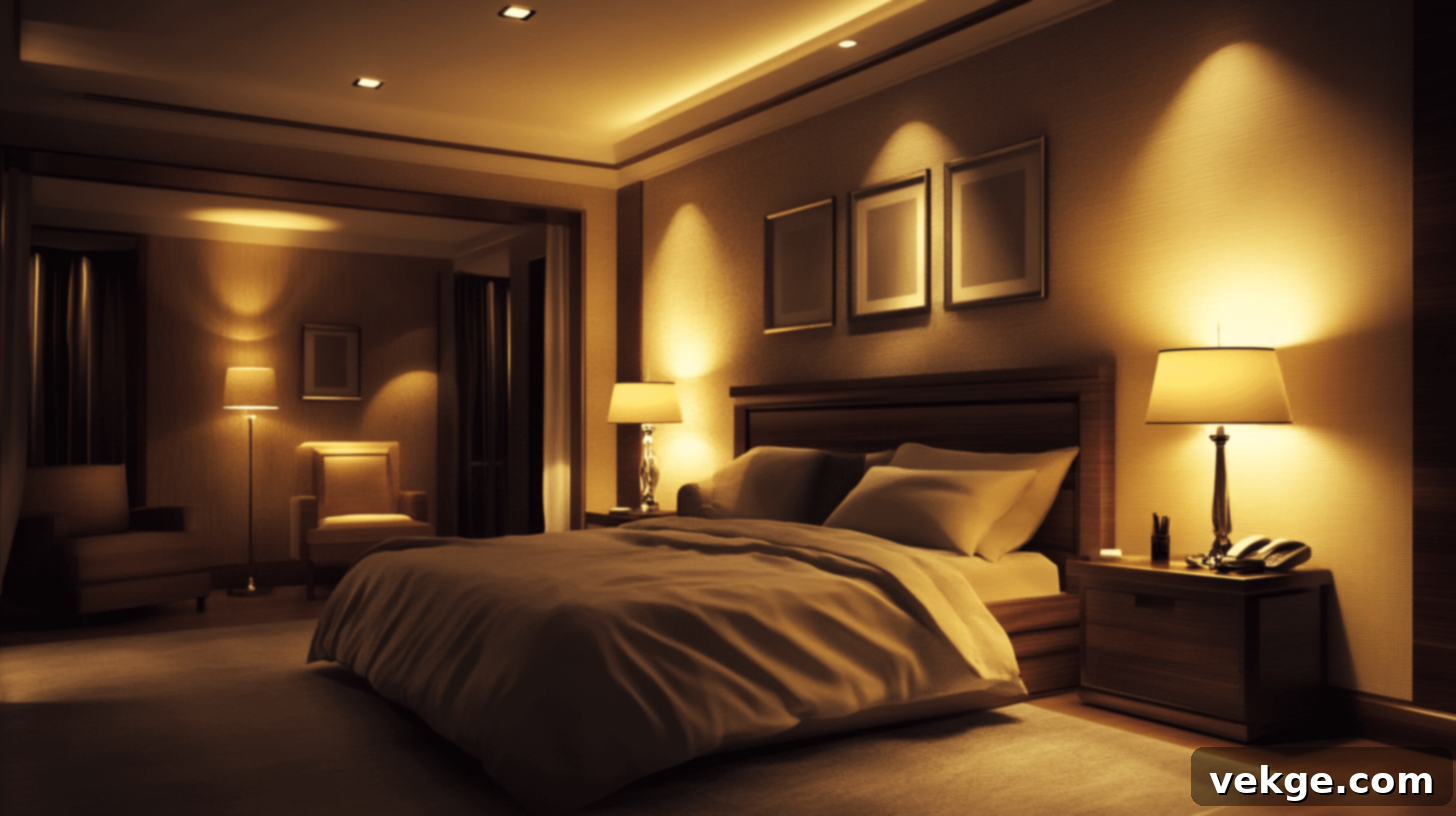
Effective lighting is about more than just brightness; it’s about creating layers that cater to various needs and moods. A well-lit room typically incorporates three types of lighting: ambient, task, and accent. Ambient lighting, usually a main ceiling fixture, provides general illumination. Task lighting, such as bedside lamps or a desk lamp, is crucial for specific activities like reading or working. When placing bedside lamps, aim for the bottom of the shade to be at shoulder height when you’re sitting in bed for optimal reading light. Accent lighting, like dimmer-controlled wall sconces or decorative lamps, adds warmth and highlights architectural features or artwork. Installing dimmer switches on all lights allows you to easily adjust the brightness and create different ambiances. Floor lamps are excellent for illuminating dark corners or creating a cozy reading nook without taking up valuable surface space.
3. Window Treatments: Style and Privacy
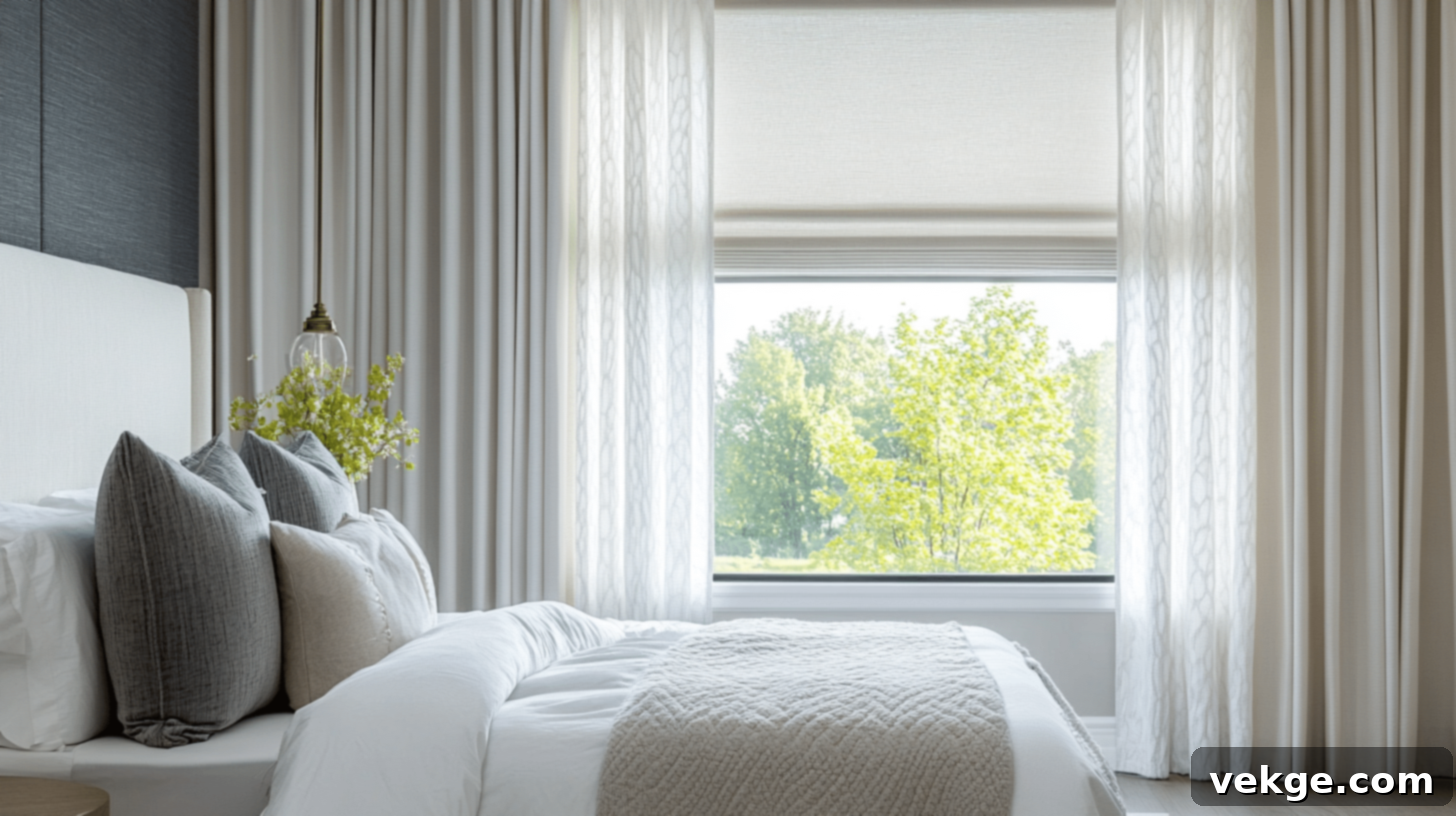
Window treatments serve multiple purposes: controlling light, ensuring privacy, and adding significant aesthetic value. Blackout curtains are fantastic for ensuring a restful sleep, especially in bedrooms, by completely blocking external light. However, they can sometimes feel heavy or bulky. A popular and versatile solution is layering: combine sheer curtains underneath heavier panels. This allows you to let in diffused natural light during the day while maintaining privacy, and then draw the heavier panels for full light blockout at night. Roman shades are an elegant, space-saving option, particularly well-suited for smaller rooms where voluminous curtains might overwhelm the space. To create the illusion of taller ceilings and larger windows, hang your curtain rods several inches higher and wider than the actual window frame. Finally, select fabrics and patterns for your window treatments that complement your existing textiles and overall room style for a cohesive and polished look.
4. Bedding and Textiles: Comfort and Texture
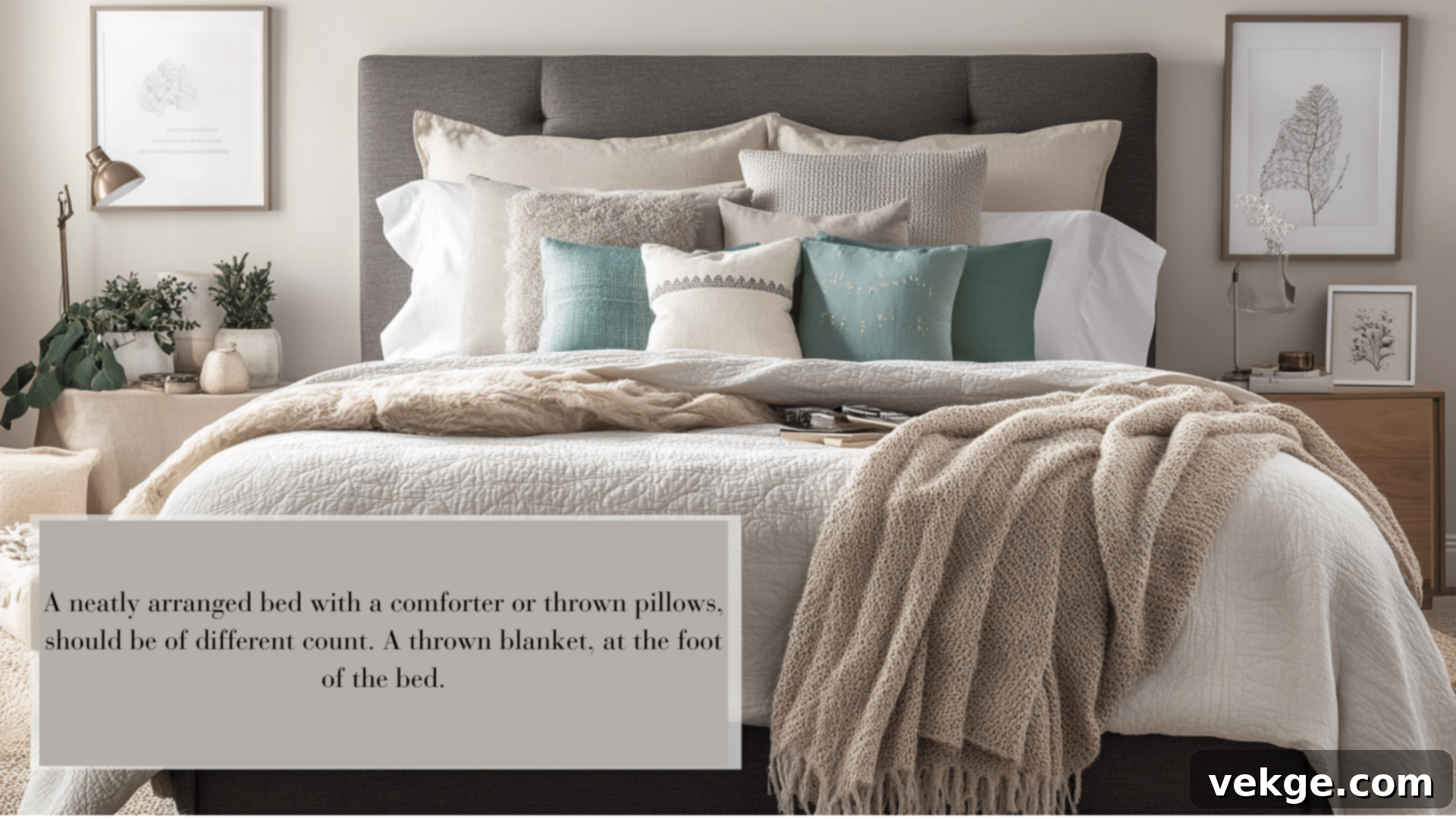
In a bedroom, bedding and textiles are paramount for comfort, warmth, and visual appeal. Start with high-quality sheets; cotton with a thread count of 300-500 offers a luxurious feel without an exorbitant price tag. Layer your bed with a comforter or duvet that suits your personal warmth preference and complements your color scheme. Add decorative throw pillows in varying shapes, sizes, and textures to introduce visual interest; limit them to 2-3 for a clean, minimalist look, or more for a plush, inviting feel. A soft throw blanket draped casually over the foot of the bed or a chair adds an extra layer of warmth for chilly nights and introduces another tactile element to the space.
5. Art and Accessories: Personal Touches
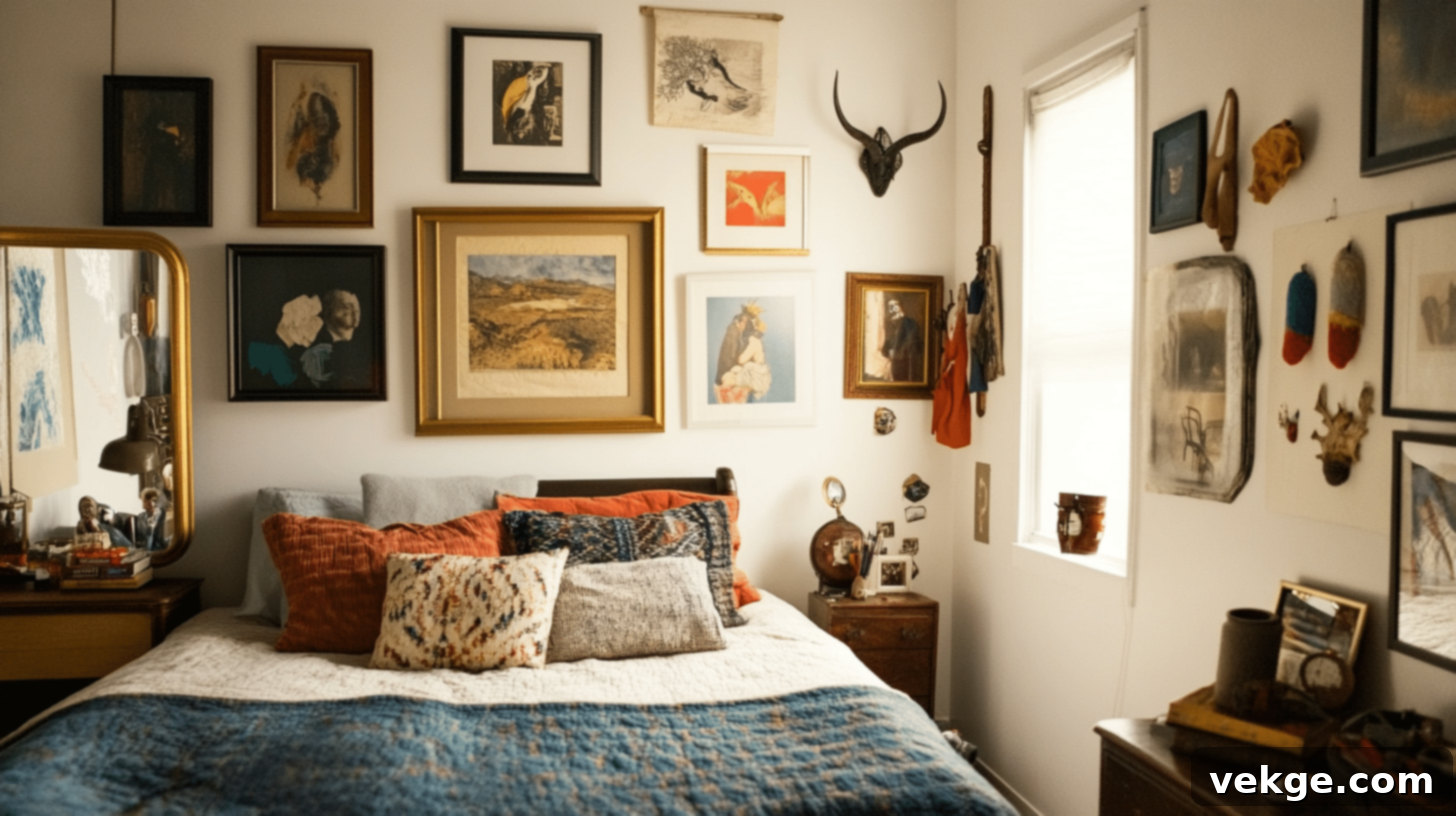
Art and accessories are where your personality truly shines. When hanging artwork, position it at eye level (typically about 60-66 inches from the floor to the center of the piece) for optimal viewing. Don’t be afraid to group smaller frames together to create an impactful gallery wall. Mirrors are not just for checking your reflection; strategically placed, they can reflect natural light from windows, making a room feel larger and brighter. Incorporate personal items that hold sentimental value, such as travel souvenirs, cherished family photographs, or handmade pottery. However, resist the urge to over-accessorize. Keep surfaces mostly clear, featuring just a few meaningful and well-chosen items to prevent a cluttered and overwhelming feel. Remember the “rule of odd numbers” for grouping accessories—items arranged in groups of three or five often look more visually appealing.
DIY vs. Hiring Professionals: Making the Right Choice
One of the biggest decisions in any remodeling project is determining which tasks you can handle yourself and when it’s essential to call in the experts. DIY projects can save significant money, but knowing your limits is crucial to avoid costly mistakes and potential safety hazards.
You can confidently tackle many simple tasks yourself, such as painting walls, hanging curtains, assembling flat-pack furniture, or even installing peel-and-stick wallpaper. These projects require basic tools, a bit of patience, and a willingness to learn. They are perfect for budget-conscious homeowners looking to make an immediate impact.
However, more complex jobs involving electrical wiring, intricate plumbing, structural changes, or specialized installations (like custom cabinetry or intricate tiling) almost always warrant hiring professionals. These tasks often require specific licenses, specialized tools, and a deep understanding of building codes and safety regulations. While DIY flooring can be feasible for click-lock laminate or vinyl planks, traditional tile and hardwood installation typically require expert precision for a durable and flawless finish.
Always be honest about your skills, available time, and physical capabilities. Sometimes, the initial cost of paying professionals is less than the expense and frustration of rectifying DIY mistakes, which can include damaged materials, unsafe installations, or delays. Get multiple quotes and check references for any contractor you consider.
Budget-Friendly DIY Projects to Transform Your Room This Weekend
If you’re eager to roll up your sleeves and make a noticeable difference without emptying your wallet, these five simple weekend projects are perfect for transforming your bedroom or any room:
- Paint an Accent Wall: Instead of committing to painting the entire room, choose one wall and paint it a bold, contrasting, or deep color. This creates a focal point, adds personality, and requires less paint and time.
- Update Hardware: Instantly modernize old dressers, nightstands, and doors by replacing outdated drawer pulls, cabinet knobs, and doorknobs with stylish new hardware. This small detail makes a huge visual impact.
- Create a Gallery Wall: Collect frames from thrift stores, dollar stores, or sales. Paint them all the same color (e.g., matte black, crisp white, or gold) for a cohesive look. Then fill them with personal photos, art prints, or even interesting fabric swatches to create a striking gallery wall.
- Make Custom Throw Pillows: Use fabric remnants, old blankets, or even upcycled clothing to create unique throw pillow covers. No-sew options using fabric glue or iron-on tape are available if you don’t own a sewing machine.
- Install Peel-and-Stick Wallpaper: For a temporary but dramatic design change, peel-and-stick wallpaper is a fantastic option. It comes in countless patterns and textures, is relatively easy to install, and can be removed without damaging walls, making it ideal for renters or those who love to change their decor frequently.
Wrapping Up Your Room Remodeling Journey
Room remodeling doesn’t have to be an overwhelming or prohibitively expensive endeavor. As this guide illustrates, even small, strategic updates can yield significant transformations in how your home looks and feels. Whether you’re aiming for a full overhaul or just a subtle refresh, the ideas presented here offer a solid starting point for reimagining and revitalizing your space.
You can begin with minor, low-commitment changes, such as applying a fresh coat of paint, updating your lighting fixtures, or simply rearranging your existing furniture to optimize flow. Adding elements like indoor plants or new textiles can also instantly uplift a room. For more ambitious changes, remember to approach the project one step at a time. The most important elements for success are a well-thought-out plan, a clearly defined budget that works for your financial situation, and a willingness to embrace both DIY efforts and professional help when needed.
Ultimately, the goal of any room remodeling project is to create a space that feels authentic, comfortable, and truly right for you and your family. So, what room will you choose to start with? Perhaps a refreshing bathroom update or a cozy bedroom refresh is in store for your next weekend project. The possibilities are endless, and the satisfaction of transforming your home is immense.
Frequently Asked Questions About Room Remodeling
What is the First Thing to Do When Remodeling a Bedroom?
The very first step for a bedroom remodel is to define your goals and budget, followed by decluttering and creating a floor plan. Once planning is complete, tackle the ‘messy’ work first, such as any wall repairs or significant structural changes. Then proceed with painting, updating radiators or vents, and finally, installing new flooring.
How Much Does it Cost to Redo a Room?
The cost to redo a room varies significantly. Basic cosmetic changes for a typical bedroom (paint, new light fixture, updated decor) might cost around $1,000 to $5,000. A medium renovation, including new flooring and some furniture, could range from $5,000 to $15,000. A complete room renovation, involving new layouts, extensive electrical/plumbing work, custom built-ins, or high-end finishes, can range from $15,000 to $40,000 or more, depending on the room and location.
How Long Does it Take to Renovate a Room Fully?
The timeline for a full room renovation depends on its complexity. A major cosmetic update can typically be completed within 1-2 weeks. However, if the project involves significant structural changes, electrical rewiring, new plumbing, or custom installations, a full renovation could take anywhere from 3-8 weeks, or even longer for very complex projects, especially when factoring in lead times for materials and contractor scheduling.
Can I Live in My House During a Major Room Remodel?
For a single room remodel, it’s usually possible to live in your house, especially if you can close off the work area. However, expect some dust, noise, and disruption. For full home renovations or projects impacting essential facilities like bathrooms or kitchens, you might need to make temporary living arrangements or set up temporary facilities during certain phases of the remodel.
